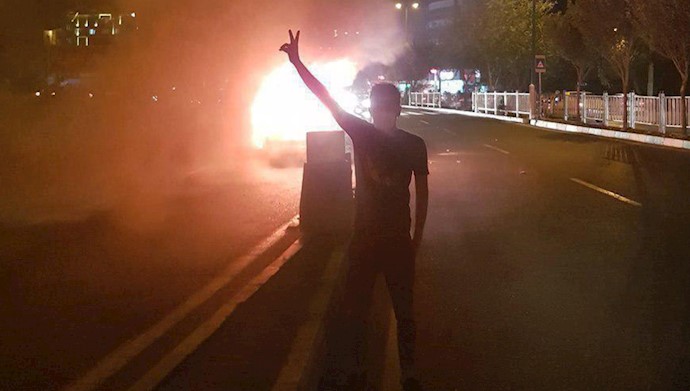The anxiety of Iranian regime supreme Ali Khamenei intensifies as the date for the fraudulent parliamentary election approaches. It is trapped in a terrifying impasse. On the one hand, societal conditions have reached a boiling point and is on the verge of explosion. Even a simple debate between two regime insiders can act as a catalyst. His Friday prayer leaders also warn that the experience of the 2009 uprising should not be forgotten and “should not be erased from the historical memory of the Iranian people.”
On the other hand, Khamenei is deeply afraid that a widespread boycott of the elections will further highlight the illegitimacy of his regime. He fears that it could turn into a “March 2 referendum against the regime” and once again pose a high risk of uprising. This political impasse, combined with the volatile internal situation, is further complicated and prolonged by the Gaza war, which means the difficult regional circumstances for the regime. All these factors contribute to a more comprehensive understanding of Khamenei’s predicament.
Constant locations of protests
In this critical situation, the regime’s unresolved crises can be seen at every corner. One example of this is the explosive conditions in marginalized areas, such as the city of Karaj and its surrounding areas in Alborz province. The constant unrest in these regions reflects the deep-rooted dissatisfaction and grievances of the people.
On January 7, the state-run Ham-Mihan newspaper wrote, “As this province [Alborz] and especially Karaj have turned from temporary to permanent residences of citizens, it has cause discontent of many people of various cities of province, the extent that Karaj and Gohardasht have become constant locations of protests in recent years.”
Of course, it is evident that the “discontent of many people in various cities of this province” is not directly related to the fact that these areas are cities or provinces. If this issue is indeed true, it is merely one of the many secondary and tertiary factors contributing to the unrest in those areas. The root cause of the general dissatisfaction of the people in these cities must be sought elsewhere, namely poverty, destitution, oppression, tyranny, injustice, and discrimination. These issues cast a wide shadow across the country, but they are exacerbated in the outskirts of cities, leading to a more rebellious atmosphere in these areas.
Intensified repression and oppression
It should be noted that contrary to the regime’s plans, the severity of repression in these areas has had a direct correlation with the intensity of the “protests.” The more the regime resorts to suppression and increases the number of prisons to quell the rebels, the less successful it becomes in containing the situation and the more it fuels the anger of the people.
The Ham-Mihan newspaper added, “The city of Karaj is surrounded by Kachooi prisons, the Central Prison, Rajai Shahr prison, and Ghezal Hesar prison… In a study, it was revealed that the prisons in Karaj have contributed to the stagnation of political development, the emergence of social challenges, including an increase in crime, informal settlements, and cultural and anti-value challenges [protests and uprising].”
Another example of the inverse consequences of these dungeons in Karaj is the vibrant atmosphere that manifested itself particularly during the 2022 uprising. Many times, it took the form of gatherings by the families of prisoners and protest against the unjust death sentences in front of these prisons. One notable example was the evening of January 8, 2023, when news of the transfer of Mohammad Ghobadlou and Mohammad Boroujeni to solitary cells quickly led their families, along with a large crowd, to gather in front of the Gohardasht Prison. They chanted slogans throughout the night, and subsequent events unfolded that ultimately forced the regime to evacuate and shut down Gohardasht Prison.
Another notable point is the intensified oppression and injustice that the people of these regions experienced during the dark years of the mullahs ruling Iran. The deprived people in these cities, as a result, are constantly faced with more harassment and discrimination, even under the same judiciary and existing laws.
Under the disgraceful rule of the mullahs, being geographically distant and far from the capital results in extra harassment, judicial persecution, and fabricated court cases. According to a January 3 report by Ham-Mihan, “An action or behavior that is considered normal and customary in Tehran, just 30 kilometers away, can lead to legal persecution, the creation of a case, and punishment in the city of Karaj. Lawyers in different cities are deeply troubled by this matter.”
If we look at the recent statistics of executions, once again, two prisons, Ghezel Hesar and Karaj Central Prison, stand out in this regard, indicating the volatile atmosphere in these areas.
According to the regime’s own media, none of the oppressive tools such as imprisonment, execution, and harsher sentences have been effective, and day by day, they have deepened the divide between the people and the regime.
On January 3, 2024, Khamenei said, “Anyone who opposes the elections is opposing the Islamic Republic.” He should be aware that if previous statistics by his own regime indicated a 96% hostility towards him from the Iranian people, these numbers have now increased even further. Instead of focusing on elections, Iranian cities in general, and especially peripheral areas, are casting their votes with their feet, in the streets and protests.
On January 7, Khabar Online quoted MP Mohammad Javad Koulivand as saying, “In the Alborz province, for example, in the previous elections, especially in the second round, the turnout did not even reach 2% to 3% of the individuals who participated in the voting booths.





